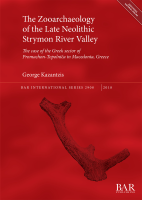Description
Excavations on the border between Greece (sector Promachon) and Bulgaria (sector Topolniča) in the basin of the river Strymonas, in Macedonia northern Greece, have revealed a ‘flat-extended’ settlement dating to the Late Neolithic. In addition to the rich array of material culture evidence, the excavation yielded a substantial quantity of animal bones, thus offering an unparalleled opportunity to study the human-animal relationships. This book focuses on the study of the faunal assemblage from the Greek sector of Promachon, and examines the role and the contribution of domestic and wild animals in subsistence. This information is especially valuable considering the scarcity of faunal data from contemporary settlements across the basin of the Strymonas during a time period (the 5th millennium BC) that is considered one of the most dynamic eras in the prehistory of southeastern Europe. This study also clarifies trends in animal management at both the micro and the macro scales, through a detailed comparison of faunal data between Promachon and other contemporary sites from northern Greece and the Balkan regions.
AUTHOR
George Kazantzis received his PhD in Zooarchaeology in 2015 from the University of Sheffield, UK. He is involved in a number of projects dealing with the study of faunal assemblages from northern Greece, with Neolithic Macedonia as his primary research interest. In recent years he has also been working on prehistoric faunal assemblages from southern Greece and the Cyclades.
REVIEWS
‘…the quality of the information is outstanding for the most part due to the good preservation of the remains, this corpus should turn into a seminal resource for the region in the years to come.’ Arturo Morales-Muñiz, Archaeofauna, International Journal of Archaeozoology, Volume 28, Oct 2019
‘The author combines “classical” archaeozoological research methodology based on morphological animal bone identification with modern insights into taphonomy and subtle cultural interpretations. … This is not only an important contribution to understanding Late Neolithic animal exploitation at an important archaeological site in Greek Macedonia, but also has broader implications for other regions.’ Prof. László Bartosiewicz, Stockholm University
‘The quality of the data is very high. … In terms of the time period it covers, the region it focuses on, and the quality of the methods and data, this is a substantial contribution to existing scholarship.’ Dr Canan Çakırlar, Groningen Institute of Archaeology, Netherlands











